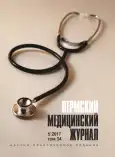SIGNIFICANCE OF MATRIX METALLOPROTEINASE-9 IN DEVELOPMENT OF COGNITIVE DISORDERS DURING ACUTE PERIOD OF ISCHEMIC STROKE
- Authors: Kalinsky DP1, Khlystov Y.V2, Kalinsky PP3, Golovina OS3
-
Affiliations:
- 1477 Военно-морской клинический госпиталь МО РФ
- Военно-медицинская академия имени С.М. Кирова
- Тихоокеанский государственный медицинский университет
- Issue: Vol 34, No 5 (2017)
- Pages: 49-54
- Section: Articles
- URL: https://journals.rcsi.science/PMJ/article/view/7281
- DOI: https://doi.org/10.17816/pmj34549-54
- ID: 7281
Cite item
Full Text
Abstract
Full Text
##article.viewOnOriginalSite##About the authors
D P Kalinsky
1477 Военно-морской клинический госпиталь МО РФ
Email: k888dp@gmail.com
старший ординатор неврологического отделения 690005, г. Владивосток, ул. Ивановская, 4
Yu V Khlystov
Военно-медицинская академия имени С.М. Кироваординатор клиники нервных болезней 194044, г. Санкт-Петербург, ул. Академика Лебедева, 6
P P Kalinsky
Тихоокеанский государственный медицинский университетдоктор медицинских наук, профессор кафедры психиатрии и неврологии 690002, г. Владивосток, пр-т Острякова, 2
O S Golovina
Тихоокеанский государственный медицинский университетаспирант кафедры общей и клинической фармакологии 690002, г. Владивосток, пр-т Острякова, 2
References
- Гомазков О.А. Системы нейрохимической регуляции при патологии мозга. Биомедицинская химия 2004; 50 (4): 322-343.
- Захаров В.В., Вахнина Н.В., Громова Д.О. Диагностика и лечение когнитивных нарушений после инсульта. Медицинский совет 2015; 10: 14-20.
- Михайленко А.А. Топическая диагностика в неврологии. СПб.: Гиппократ 2000; 262 с.
- Одинак М.М., Емелин А.Ю., Коваленко П.А., Лобзин В.Ю. Нарушение когнитивных функций при сосудистых поражениях головного мозга в практике военного невролога. Военно-медицинский журнал 2009; 4: 32-40.
- Суслина З.А., Гулевская Т.С., Максимова М.Ю., Моргунов В.А. Нарушения мозгового кровообращения: диагностика, лечение, профилактика. М.: МЕДпресс-информ 2016; 536.
- Чердак М.А., Яхно Н.Н. Постинсультные когнитивные расстройства. Журнал неврології ім. Б.М. Маньковського 2013; 1: 31-37.
- Leys D., Неnon H., Mackowiak-Cordoliani M.A. Poststroke dementia. Lancet Neurology 2005; 4 (11): 752-759.
- The atlas of heart disease and stroke. ВОЗ 2004.
- Tobin M.K., Bonds J.A., Minshall R.D., Pelligrino D.A., Testai, F.D., Lazarov O. Neurogenesis and inflammation after ischemic stroke: what is known and where we go from here. Journal of Cerebral Blood Flow & Metabolism 2014; 34 (10): 1573-1584.
- Whiteley W., Jackson C., Lewis S. Inlammatory markers and poor outcome after stroke: a prospective cohort study and systematic review of interleukin-6. PLoS Medicine 2009; 6 (9) Article ID e1000145.severity.
Supplementary files






